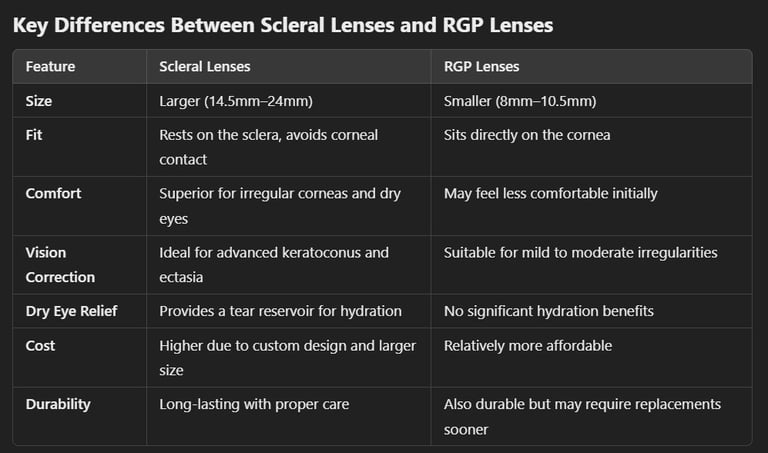Scleral lens vs RGP for Keratoconus
The choice between scleral lenses and RGP lenses depends on several factors, including the severity of keratoconus, corneal sensitivity, and lifestyle preferences. Scleral Lenses are recommended for advanced keratoconus, dry eyes, or those who experience discomfort with RGP lenses. RGP Lenses are a good option for patients with mild keratoconus or those seeking a cost-effective solution.
BLOG POSTKERATOCONUSSCLERAL LENSRGP LENSRGP
Scleral Lenses vs. RGP Lenses for Keratoconus: A Complete Guide
Keratoconus is a condition where the cornea becomes thin and develops an irregular, cone-like shape. This can affect vision to a great degree, making it really difficult to correct with standard glasses or contact lenses. Two options usually recommended for keratoconus patients are Scleral Lenses and Rigid Gas-Permeable (RGP) lenses.
Each one of these lenses has unique benefits and considerations. Let us explore how Scleral lenses and RGP lenses compare in terms of fit, comfort, vision correction, and suitability for managing keratoconus.
What Are Scleral Lenses?
Scleral lenses are contact lenses that rest on the sclera (the white part of the eye) rather than cornea. These lens have large-diameter and create a reservoir that is tear-filled. It protects and hydrates the cornea while providing clear vision.
Features of Scleral Lenses
Size: These are larger than traditional lenses, typically between 14 mm and 20 mm( diameter).
Fit: Vaults over the cornea. They do not make any direct contact with the corneal surface.
Comfort: Cushions the eye and reduces irritation (helpful for people with corneal sensitivity.
Potential Disadvantages
The fitting process for scleral lenses can take longer and may require multiple appointments.
They tend to be more expensive compared to other types of contact lenses.
What Are RGP Lenses?
Rigid gas permeable (RGP) lenses are small is size (hard contact lenses) and they rest directly on the cornea. These improve vision by reshaping the front surface of the eye and correcting irregularities in the eyes of patients with keratoconus.
Key Features of RGP Lenses
Size: Smaller in size than scleral lenses (usually 8 mm to 12 mm in diameter).
Fit: They are designed so that they sit on the corneal surface. They offer precise vision correction.
Durability: These are made from long-lasting materials and hence they provide good value over time.
Advantages of RGP Lenses
Typically, more budget-friendly than scleral lenses.
Beneficial for mild to moderate keratoconus.
Their size makes them easier to insert and remove.
Disadvantages of RGP Lenses
Can feel uncomfortable, especially during the initial adjustment period, as they rest on the cornea.
May not be suitable for advanced keratoconus or significantly irregular corneas.
Reference : Contact Lens Spectrum

